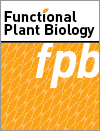
Functional Plant Biology
Volume 48 Number 11 2021
FP20368Single-cell-type transcriptomic analysis reveals distinct gene expression profiles in wheat guard cells in response to abscisic acid

Our knowledge concerning stomatal function is still very limited in wheat (Triticum aestivum L.), the most important food crop worldwide. In this paper, we identified many abscisic acid (ABA)-regulated genes and elements associated with stomatal regulation using wheat as a model. Our findings provide a valuable resource for investigating the transcriptional regulatory mechanism underlying wheat guard cell response to ABA and useful information for crop response to environmental factors.
Wounding induces the production of various hormones, which in turn, stimulate wound suberisation. However, the stage of wound healing and the interactions among assorted hormones in response to wounding have not been studied in kiwifruit (Actinidia chinensis Planch.). In wound healing of kiwifruit, ABA might be involved in the coordination of both JA-mediated suberin monomers biosynthesis and t-ZT- and IAA-mediated formation of suberised cells via an interaction mechanism.
FP21161Silver nanoparticles (AgNPs) internalization and passage through the Lactuca sativa (Asteraceae) outer cell wall
 , Thaiz Batista Azevedo Rangel Miguel, Marlos de Medeiros Chaves, Francisco Claudio de Freitas Barros, Camila Pessoa Farias, Thiago Alves de Moura, Odair Pastor Ferreira, Alexandre Rocha Paschoal, Antonio Gomes Souza Filho and Emilio de Castro Miguel
, Thaiz Batista Azevedo Rangel Miguel, Marlos de Medeiros Chaves, Francisco Claudio de Freitas Barros, Camila Pessoa Farias, Thiago Alves de Moura, Odair Pastor Ferreira, Alexandre Rocha Paschoal, Antonio Gomes Souza Filho and Emilio de Castro Miguel
The interaction of nanoparticles with the cell wall consists of a dynamic process, and the mechanism of passing silver nanoparticles through the cell wall is not well understood. Silver nanoparticles bind to the cellulose structure and create pores in the cellulose microfibrils. The spaces generated facilitate the passage of Ag+ and Ag0 through the cell wall causing toxicity to the plant.
Delayed leaf yellowing in maize may result in higher yields under drought due to an extended period for light interception. However, our results show that this trait can be a consequence of a shallower root system that improves water use efficiency and water availability during the reproductive period and prolongs root survival, but does not necessarily imply yield gains. Further delaying leaf yellowing by breeding could be counterproductive if roots compete with grains for photosynthates.
FP20400Large DNA fragment deletion in lncRNA77580 regulates neighboring gene expression in soybean (Glycine max)
A recently discovered gene (long non-coding RNA) plays important roles in plant growth and environmental adaptation, but studying their functions is till a big challenge because they do not code the proteins. We succeeded in deleting the large fragment of gene with gene editing tools in soybean. In obtaining functional mutations, it is possible to know the mechanism of their function in response to stresses and during growth and development of plant that is benefit for crop molecular breeding.
FP21140Identifying the genetic control of salinity tolerance in the bread wheat landrace Mocho de Espiga Branca
 , Juan Carlos Sanchez-Ferrero, Paul J. Eckermann, Nathan S. Watson-Haigh, Bettina Berger, Allison S. Pearson and Stuart J. Roy
, Juan Carlos Sanchez-Ferrero, Paul J. Eckermann, Nathan S. Watson-Haigh, Bettina Berger, Allison S. Pearson and Stuart J. Roy 
Enhancements in wheat salinity tolerance are required to ensure productivity. We identified a wheat landrace accumulating higher leaf sodium than current cultivars with no detrimental effects, along with genetic regions linked to this tolerance. This provides an opportunity to focus on other salt tolerance mechanisms other than sodium exclusion.
FP21140 Abstract | FP21140 Full Text | FP21140PDF (2.2 MB) | FP21140Supplementary Material (2.1 MB) Open Access Article
P and Se interaction in the soil–plant system is affected by their distribution in soil. We analysed two distribution patterns of P and Se in soil on the P- and Se-uptake efficiency in alfalfa (Medicago sativa L.). Results indicated localised P supply promoted P and Se uptake by increasing the amount of rhizosheath carboxylates and weakening the competition between roots and microbes. Translocation of Se within plant organs was promoted by the application of P, thus enhancing the P-uptake efficiency.
FP20386Metabolic programming of Rhododendron chrysanthum leaves following exposure to UVB irradiation
Rhododendron chrysanthum is a kind of ornamental plant with high medicinal value. The accumulation of flavonoids, organic acids, amino acids and fatty acids, accompanied by enhancement of TCA cycle and arginine biosynthesis, may protect R. chrysanthum plants against UVB deleterious effects.
FP20386 Abstract | FP20386 Full Text | FP20386PDF (1.4 MB) | FP20386Supplementary Material (260 KB) Open Access Article
The dot-like browning appeared in Chinese cabbage (Brassica campestris L.) has a negative impact on the sensory characteristics. We found the enhanced autofluorescent substances in the trichomes during leaf senescence is not the browning products. It is speculated that the formation of the browning products probably arise from the accumulation of mineral element that active the enzymatic browning locally in the trichomes. The results may provide important information regarding the mechanism of the formation of browning in trichomes.




